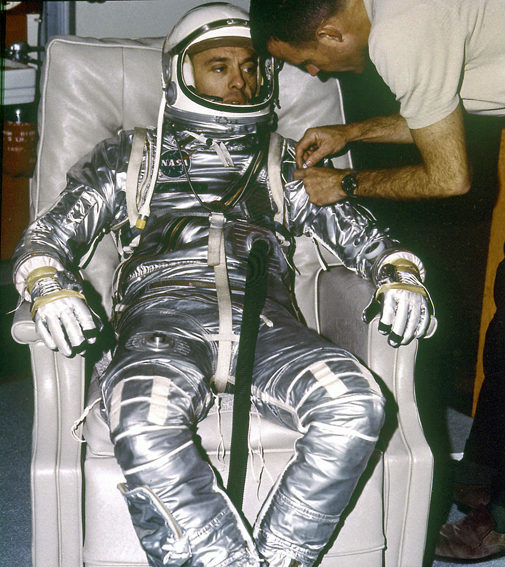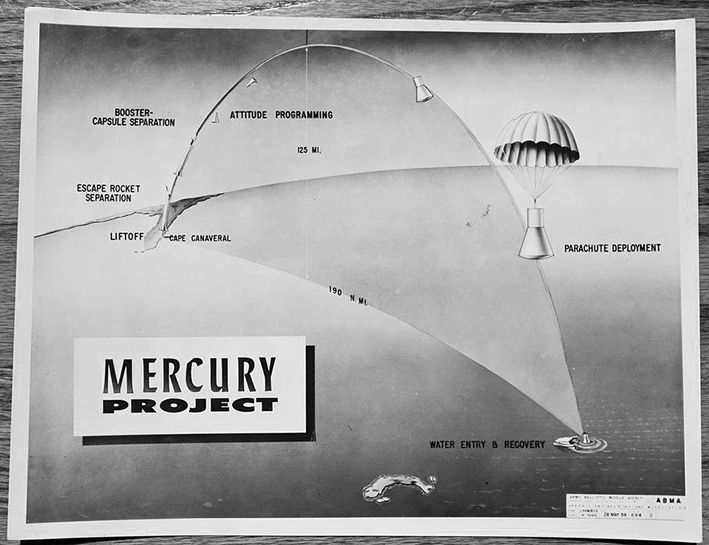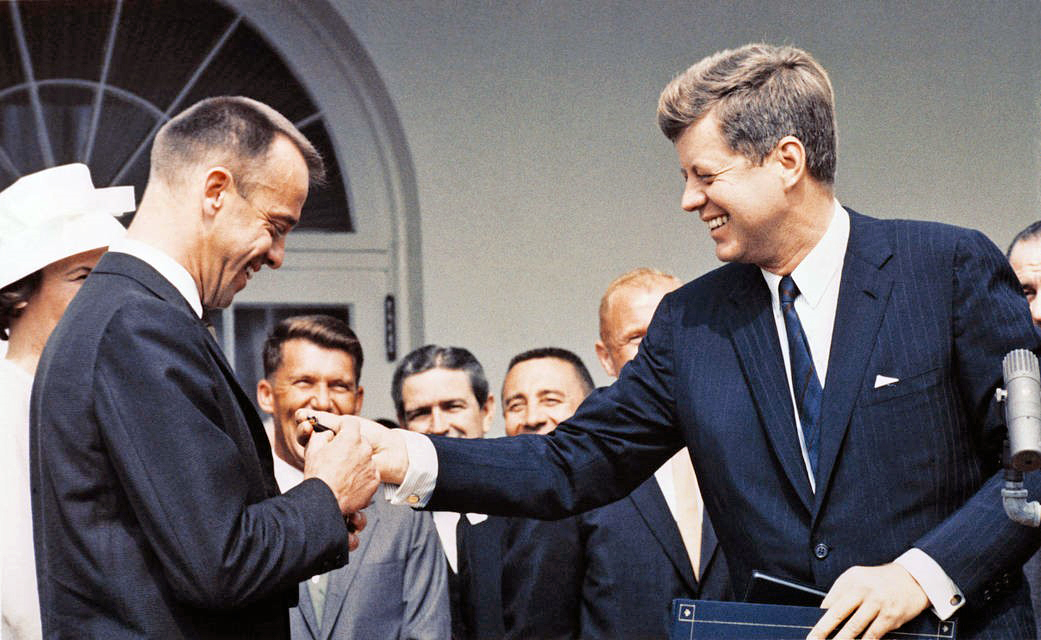


Alan B. SHEPARD |
|
PROFILE |
|
Full Name: |
Alan Bartlett SHEPARD Jr. |
Rank: |
Rear Admiral, US Navy (Deceased). |
Born: |
18 November 1923, in East Derry, New Hampshire, USA (American). |
Died: |
21 July 1998, from leukaemia, in Pebble Beach, California, aged 74. |
Education: |
1940: Graduated from Pinkerton Academy, Derry, New Hampshire.
1944: BSc degree from the US Naval Academy. |
Career Highlights: |
1941-44: Student, US Naval Academy.
1944-45: Ensign on the destroyer USS Cogswell (DD-561); deployed in the Pacific.
1945-47: Naval aviator flight training.
1947-48:Naval Aviator and Instructor with the Naval Auxiliary Air Station (NAAS) Cecil Field, Jacksonville, Florida; Fleet Airborne Electronics Training Unit, Naval Air Station (NAS) Norfolk, Virginia and Fighter Squadron 4B then 42 (VF-42), completing tours in the Mediterranean.
1950-51: Attended and graduated US Naval Air Test Center, Patuxent River, Maryland.
1951-57: Completed two tours at the Air Test Center, interspersed between 1953 and 1956 with service as Operations Officer, Fighter Squadron 193, Moffett Field, California. This was a night-fighter unit and he completed two trips to the Western Pacific aboard the carrier USS Oriskany (CVA-34). While serving as a test pilot, he participated in trials for naval in-flight refuelling and for the first angled deck for aircraft carriers, as well as carrier suitability trials for the F2H3 Banshee. He tested the F3H Demon, F8U Crusader, F4D Skyray and F11F Tigercat and served as Project Test Pilot on the F5D Skylancer.
1957-59: Attended Naval War College, Newport, Rhode Island; (1958) served as the Aircraft Readiness Officer on the staff of the Commander-in-Chief, US Atlantic Fleet. |
|
|
NASA ASTRONAUT ASSIGNMENTS |
|
1959: |
(9 Apr) Selected as one of the seven original Mercury astronauts chosen by NASA; Mercury training; (Jul) Astronaut Office (Code CB) technical assignment in tracking and recovery operations; Mercury training. |
1960: |
Mercury training. |
1961: |
Mercury training; (21 Feb) identified but not made public as prime Pilot (PLT) for the first sub-orbital mission; Mercury training; (2 May) publicly identified as the first American to launch to space after first launch attempt was scrubbed due to weather; (5 May) flew as PLT Mercury-Redstone 3 (MR-3) Freedom 7; sub-orbital mission (15 min 28 sec); FIRST AMERICAN IN SPACE; (Jul) Capcom MR-4 (Grissom). |
1962: |
Mercury training; (Feb) Capcom MA-6 (Glenn); (May) Capcom MA-7 (Carpenter); (Oct) Capcom MA-8 (Schirra); (13 Nov) named BUp PLT MA-9 (Cooper); Mercury training. |
1963: |
(26 Jan) Specialty CB assignment - Pilot Phases of Project Mercury; Mercury training; (May) BUp PLT MA-9; prime candidate for assignment to three-day MA-10 mission; (May) tentatively diagnosed with Ménière's disease (an inner ear infection) and temporarily grounded; (Jun) MA-10 cancelled as unnecessary; (Jul) restored to flight status and informed he would be Command Pilot for Gemini 3, the first crewed flight of the series; (Oct) medical diagnosis confirmed and he was grounded again, losing Gemini 3; (Nov) named as Chief of the Astronaut Office, MSC Houston. |
1964: |
Chief of the Astronaut Office. |
1965: |
Chief of the Astronaut Office. |
1966: |
Chief of the Astronaut Office. |
1967: |
Chief of the Astronaut Office. |
1968: |
Chief of the Astronaut Office; (second half) corrective surgery. |
1969: |
Chief of the Astronaut Office; (Mar) restored to full flight status; (Jun) assigned as Commander (CDR) Apollo 13; assignment rejected by NASA HQ due to the inexperience of Shepard and his crew (Ed Mitchell and Stu Roosa); crew reassigned to Apollo 14; (6 Aug) named as CDR Apollo 14; replaced as Chief of the Astronaut Office for the duration of the Apollo 14 mission by Tom Stafford; Apollo mission training. |
1970: |
Apollo mission training. |
1971: |
Apollo mission training; (31 Jan - 9 Feb) flew as CDR Apollo 14 (9 days 0 hrs 1 min); 3rd lunar landing mission; became 5th and oldest man (aged 47) to walk on the Moon; only Mercury Seven astronaut to fly to the Moon; 2 EVAs (9 hrs 24 min); (5 Feb) EVA 1 (4 hrs 49 min); (6 Feb) EVA 2 (4 hrs 35 min); total of 33 hrs 39 min on the Moon; (Jun) resumed role as Chief of the Astronaut Office, replacing Stafford. |
1972: |
Chief of the Astronaut Office. |
1973: |
Chief of the Astronaut Office; concurrently filled additional role (through to 1974) as Director, Flight Crew Operations Directorate (FCOD), standing in for Deke Slayton who was training for Apollo-Soyuz. |
1974: |
Chief of the Astronaut Office; (31 Jul) resigned from NASA and retired from the US Navy with the rank of Rear Admiral. |
|
|
POST-ASTRONAUT EXPERIENCE |
|
1974-98: |
In private business, serving as Partner and Chariman of Marathon Construction Company, Houston; President, Windwood Distributing Company; founded his own business, Seven Fourteen Enterprises, named after his two space flights; (1984-95) co-founder Mercury Seven Foundation; (1995-97) organisation renamed Astronaut Scholarship Foundation; elected President and Chairman until turning both positions over to Jim Lovell. |
21 Jul 1998: |
Died after a lengthy illness, aged 74. |
(11 Dec 2021) |
(Twenty-three years after his death, Shepard's daughter Laura Shepard Churchley emulated her father on a sub-orbital flight aboard the Blue Origin New Shepard spacecraft. At the time she was 74, the same age as her father when he died.) |
|
|
Alan SHEPARD Space Flight Missions |
||||||
Mission |
Vehicle |
Position |
Date DD/MM/YYYY |
Duration DD:HH:MM:SS |
Orbits |
EVAs (HH:MM) |
Mercury 3 |
Redstone |
Pilot |
05/05/1961 |
00:00:15:28 |
Sub-orbital |
0 |
Apollo 14 |
Saturn V |
Commander |
31/01/1971-09/02/1971 |
09:00:01:57 |
1.5 |
2* (09:24) |
|
||||||
Missions Flown: |
2 |
Total Flight Time: |
09:00:17:25 |
1.5 |
2* (09:24) |
|
*Lunar surface EVAs |
||||||
Space Explorer Achievements |
||||||
First American and second person in space (May 1961). Fifth and oldest person to walk on the Moon (Feb 1971). |
||||||






